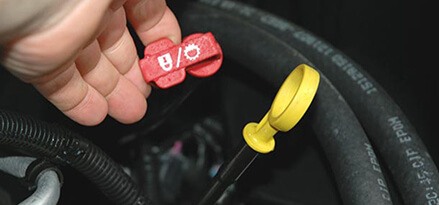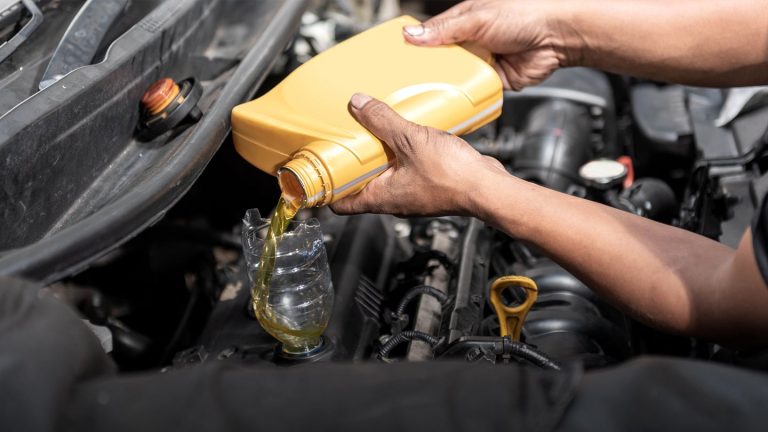Add Transmission Fluid to Sealed Transmission: A Feasible Option?

No, you cannot add transmission fluid to a sealed transmission. Sealed transmission units do not have dipsticks or filler tubes, and transmission fluid can only be added through the dealership or by a certified mechanic with the appropriate tools.
Without it, the transmission could fail, leading to costly repairs or even the need for a complete replacement. However, if you have a sealed transmission, you cannot add transmission fluid on your own as the unit is designed to be sealed and cannot be easily accessed. In this article, we’ll discuss more about sealed transmissions and what to do if you suspect there may be a problem with yours.

Credit: www.mobil.com
Understanding Sealed Transmissions
Sealed transmissions are becoming increasingly popular in the automotive industry. Unlike their traditional counterparts, sealed transmissions don’t require a dipstick for measuring fluid levels, and the fluid inside doesn’t need to be changed as often. But, what are the different types of sealed transmissions, and why are they necessary?
Let’s dive into it.
Types Of Sealed Transmissions
- Continuously variable transmissions (cvt): Cvt replaces gears with pulleys and belts that create an infinite number of ratios, giving your car a smooth acceleration.
- Dual-clutch transmissions (dct): Unlike a traditional automatic transmission, dct has two clutches that alternate gears, giving you quicker and smoother shifting.
- Direct-shift gearbox (dsg): Similar to the dct, it allows for faster and smoother shifting due to its two gear sets that work alternatively.
Additionally, some automakers have their unique versions of sealed transmission.
Importance Of Sealed Transmissions
Sealed transmissions reduce the chances of fluid loss and contamination. They require less maintenance and are more reliable. Here are some of the advantages:
- Saves on maintenance costs
- Promotes fuel efficiency
- Enhances the performance and drivability of the car
- Decreases the risk of car breakdowns
Sealed transmissions are beneficial to your vehicle in several ways. They reduce the need for transmission fluid to be changed regularly and lessen the risk of leaks. Understanding the different types of sealed transmissions and their advantages can help you make a wise decision when it comes to looking for a new car or servicing your current one.
Read More About: JWS 3309 Transmission Fluid Equivalent
Symptoms Of Low Transmission Fluid
Signs Of Low Transmission Fluid
It’s essential to know the symptoms of low transmission fluid as they can help you identify the problem before it becomes more severe. Here are some signs that may indicate your vehicle has low transmission fluid:
- Transmission slipping – when the fluid is low, your transmission may not shift gears properly and may start to slip while driving.
- Delayed engagement – if you notice a delay while shifting gears or a hesitation between gears, it could be a sign of low transmission fluid.
- Overheating – low transmission fluid can cause overheating, which can result in costly damage to your car.
- Noises – if you hear grinding or whining sounds while driving, it may be a sign of low transmission fluid.
- Warning light – some vehicles have a warning light that will illuminate when the transmission fluid is low.
Risks Of Driving With Low Transmission Fluid
Driving with low transmission fluid is not recommended. Here are some of the risks you may encounter:
- Increased wear and tear – low fluid levels can cause increased friction between the internal components of the transmission, leading to premature wear and tear.
- Costly repairs – if you continue to drive with low transmission fluid, it can cause significant damage to your transmission, resulting in costly repairs or replacement.
- Poor fuel economy – low transmission fluid can cause your vehicle to work harder than usual, leading to poor fuel economy.
- Safety risks – a malfunctioning transmission can result in unexpected gear shifting, causing an accident.
Can You Add Transmission Fluid To Sealed Transmissions?
Sealed transmission systems are becoming increasingly popular because they require less maintenance and can withstand various road conditions. However, one concern drivers have with sealed transmissions is the ability to add more fluid when necessary. This section will discuss whether it is feasible to add transmission fluid to sealed transmissions and the benefits and challenges of doing so.
Benefits Of Adding Transmission Fluid
Adding transmission fluid can offer several benefits for sealed transmissions, including:
- Increased performance: Over time, transmission fluid may become contaminated or break down. By adding fresh transmission fluid, you can improve the performance of your transmission system.
- Cost-effective solution: Adding fluid is a cost-effective solution compared to total transmission replacement.
- Improved fuel economy: Fresh transmission fluid can improve fuel efficiency, reducing the overall cost of driving.
Challenges Of Adding Transmission Fluid
While there are benefits to adding transmission fluid to sealed transmissions, there are some challenges to consider:
- Difficulty in locating the filler port: Sealed transmissions don’t generally have a filler port, making it challenging to add fluid.
- Potential for damage: Adding incorrect or too much fluid can damage the system, leading to costly repairs.
- Voiding the warranty: Sealed transmissions have specific requirements for maintenance and repairs. Adding fluid may violate the terms of the vehicle’s warranty.
Adding transmission fluid to sealed transmissions is a feasible option.
How To Add Transmission Fluid To Sealed Transmissions?
Are you having issues with your vehicle’s sealed transmission? Adding transmission fluid to sealed transmissions can seem impossible, but it’s actually feasible with the right tools and equipment.
Step-By-Step Guide For Adding Transmission Fluid
Here is a step-by-step guide for adding transmission fluid to a sealed transmission:
- Begin by checking the transmission fluid level – ensure that it’s below the recommended levels.
- Locate the transmission fluid reservoir – this can usually be found near the transmission dipstick.
- Carefully remove the transmission fluid reservoir cap, and using a funnel, pour the transmission fluid into the reservoir. Ensure that you fill it to the recommended level.
- Once the fluid is at the recommended level, replace the reservoir cap and wipe off any spills or excess fluid.
- Start your engine and allow it to run for a few minutes to allow the transmission fluid to circulate.
- Recheck the transmission fluid level and add more fluid if necessary – ensure that you never overfill it.
Tools And Equipment Needed
The following tools and equipment will be needed for you to add transmission fluid to a sealed transmission:
- Transmission fluid: It must be compatible with your car’s sealed transmission.
- Funnel: To help you pour the transmission fluid into the reservoir without spilling.
- Transmission fluid reservoir cap: To cover the reservoir after adding fluid.
Maintenance Tips For Sealed Transmissions
Are you wondering if adding transmission fluid to a sealed transmission is a feasible option? Maintenance of sealed transmissions is crucial to ensure smooth operation and extended lifespan. Here are some essential maintenance tips for sealed transmissions that every car owner should know:
Regular Maintenance Checks
Regular checks and maintenance are necessary to keep the transmission in good working condition. Here are some checks you can perform:
- Check the fluid level regularly. The sealed transmission does not have a dipstick, so you need to refer to the owner’s manual for the correct procedure.
- Look for leaks. If you see any fluids on the ground, it could signal a leak in the transmission. Get it checked by a professional mechanic.
- Make sure the fluid is clean and pinkish in color. The fluid should be replaced every 30,000 miles, or as recommended by the manufacturer.
- Follow the recommended maintenance schedule in your owner’s manual for the best maintenance care.
- Avoid overloading your vehicle to minimize wear and tear on the transmission.
- Be gentle when shifting gears. Abrupt and sudden acceleration or deceleration can put unnecessary strain on the transmission.
Importance Of Professional Maintenance
While regular maintenance checks can help keep the transmission running, it is essential to consult a professional mechanic for servicing. Here’s why:
- Professional mechanics have the experience and training to diagnose any transmission problems accurately.
- They use specialized tools and equipment to inspect and service the transmission.
- Professional maintenance can prolong the life of your transmission and prevent costly repairs down the road.
- They will ensure that the correct type of fluid is used, which is essential for sealed transmissions.
Frequently Asked Questions For Can You Add Transmission Fluid To A Sealed Transmission
Can You Add Transmission Fluid To A Sealed Transmission?
Unfortunately, you can’t add transmission fluid to a sealed transmission. It’s because such transmissions don’t have dipsticks or fill tubes. The manufacturer seals the transmission to prevent tampering or maintenance by untrained personnel. If it leaks, malfunctions or runs out of fluid, you should take it to a professional technician.
How Do You Know If Your Transmission Fluid Is Low?
The following are signs that your transmission fluid is low: difficulty shifting gears, slippage, surging or delay when driving, slipping gears, transmission overheating, slow or erratic shifting, transmission noise or whining, and a burning smell from the transmission. Check the transmission fluid level and top off if necessary.
Can You Fill A Sealed Transmission From The Breather Hole?
No, you can’t fill a sealed transmission from the breather hole or vent. Doing so could damage the transmission and void the warranty. Additionally, adding fluid through the breather hole wouldn’t fill the transmission completely, leading to low fluid levels and damage to internal components.
Why Do Transmissions Fail?
Transmissions may fail due to various reasons, such as heat breakdown, component wear and tear, blocked passages, low fluid levels, contaminated fluid, and improper maintenance. Regular maintenance, including fluid changes, helps prolong the life of the transmission and prevent costly repairs and replacements.
How Often Should You Change Your Transmission Fluid?
Manufacturers recommend changing the transmission fluid typically every 30,000 to 60,000 miles or every 2-4 years, or as per the vehicle owner’s manual. However, certain factors, such as driving regularly in stop-and-go traffic, towing heavy loads, or extreme weather conditions, may require more frequent fluid changes.
Conclusion
Adding transmission fluid to a sealed transmission is not recommended as it can cause more harm than good. The sealed design of the transmission signals that it is a self-contained unit that does not need to be serviced by the mechanic or the car owner.
Sealed transmissions are specifically built to keep the fluid clean and maintain a stable pressure level. Any attempt to add fluid can result in overfilling, which can cause the transmission to malfunction. If there is a leak or low fluid level, it is best to take the car to the dealership or a trusted mechanic for a proper diagnosis and repair.
Remember that transmission fluid is a key component in the efficiency, performance, and longevity of your vehicle’s transmission.






